Selecting the ideal tender is like picking the ideal sailboat-it depends on what you want. Within the universe of tenders are kayaks, and the diversity within this subset is just as great, with options ranging from inexpensive inflatables to pedal-drive fishing machines. Knowing we could not possibly test every kayak on the market, we focused on familiar brand names, and tested models from each maker with the hopes of answering a simple question: what kayaks best meet the specific needs of a sailor.
We tested all of the kayaks described in this review, and they represent some of the more prominent manufacturers in this field. However, there are dozens of other designs available, and many will share similar characteristics to the ones we tested. Here are some specifications to consider when shopping.
Weight. Less weight means easier hoisting, and to some extent, easier paddling. The average inflatable boat weighs around 100 pounds, and except for the pedal kayaks, all the hulls that we tested tip the scales at less than half of that. The rigged weight of the pedal kayaks ranges from about 85 to 100 pounds, including the removable drive units, which add about 15 pounds and can be loaded separately.
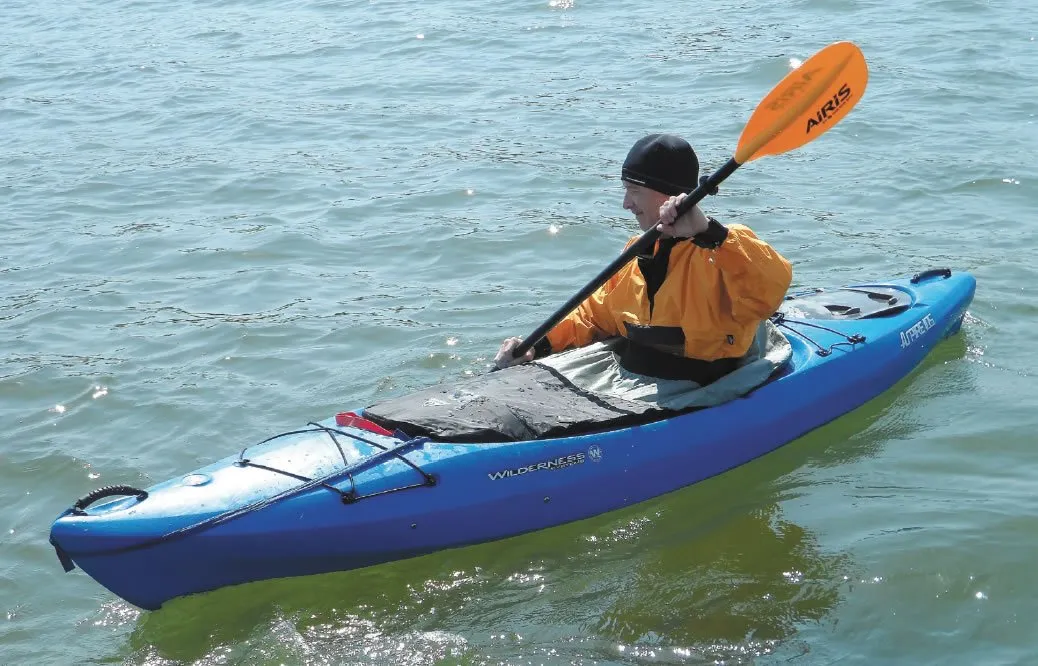
Length. Greater length generally means more speed and more carrying capacity, but only if you are paddling hard enough to reach hull speed. For most cruisers, speed doesn’t matter greatly, since you are usually anchored near what you plan to explore. More length also adds more wetted surface, more weight, and storage problems.
Beam. Greater beam means more stability, but also lower speed and less efficient paddling. It is often required to offset the higher center of gravity that comes as a result of a high seat location.
Keel. Long boats with a pronounced keel track straight, and short boats with a smooth bottom, meander as you paddle. But long keels turn sluggishly, a nuisance when exploring inside marinas and mangrove mazes. In the surf, steering responsiveness is vital. Inflatables use a rubber aft skegs and hybrid hard kayaks have retractable skegs. Inexperienced paddlers often prefer kayaks that just go straight, while more experienced paddlers prefer to maintain control with minor correction strokes.
Seat height. Seat height is just as important to stability as beam. A high seat may be comfortable, but may be unstable in a beam sea or steep wake. Sit-in kayaks place your bottom just 1 to 2 inches from the keel, whereas sit-on kayaks can be 8 to 12 inches above the bottom. The higher seats make sight fishing easier, but this comes at the price of stability.
Seat comfort. Test the boat wearing the life jacket you intend to wear. A high seat back can be more comfortable, but it can interfere with some lifejackets. Paddling-specific lifejackets feature thin flotation on the back, larger armholes, and a high cut for better comfort while paddling. This is an important consideration if you foresee rough water, where a conventional lifejacket (non-inflatable) is preferred. Only one kayak we tested, the Aspire, has adjustable seat back height.
Stability. The stability rating in the adjacent table is an average of two tests: initial stability, or how far the boat will heel before it flips; and what we call functional stability, how the boat reacts to a fast turn or steep wake or wave.
Hull Material. Since our focus was on economical models, all of our rigid hull kayaks were thermo-molded polyethylene, a cheap durable material, though not as light and stiff as more expensive fiber reinforced plastic (FRP) models. Among inflatables, all the models were coated polyester (PVC), although the quality of the material varied greatly.
Paddles. Since paddles are often purchased separately, we did not include them in the test rating, but our testers did have some favorites. How you use the paddle can have a great impact on performance (see adjacent article Paddle Performance).
What We Tested
After scouring the market it became clear that the field divided itself into two main types of kayaks:
Sit-In. Traditional kayaks have a sit-in design. These offer moderate weight, great stability and strength, good weather protection, and impressive seaworthiness in experienced hands. We focused on a recreational kayaks 9-10.5 feet long rather than true sea kayaks. A ten-footer is more practical for most sailors, due to reduced length, weight, and ease of boarding from an anchored sailboat (sea kayaks tend to be skinny and tippy, making boarding from a boat difficult). We tested sit-in kayaks from Perception and Wilderness Systems.
Sit-on-top. Sit-on-top kayaks are popular among novices, because of the concern that one could get trapped inside during a capsize (a fear that is largely unfounded), and because re-boarding a sit-on kayak from the water is easier. The downside of a sit-in kayak is that your bottom is often wet. If the seat is raised, you are more exposed to cold, wet, or rough weather. Sit-on kayaks are usually slightly heavier and slower to paddle that sit-in kayaks because of the wide, flat bottom required to provide adequate stability. We tested sit-on kayaks from Ocean Kayak and Hobie.
These categories were further split into three subsets:
Inflatable kayaks. We tested inflatable kayaks from Walker Bay, Sterns, Hobie, and Advanced Elements.
Pedal kayaks. Pedal-drive systems have offered a breakthrough for explorers and anglers who like to keep their hands free. We tested pedal kayaks from Hobie and Perception.
Folding kayaks. We are still working on a full evaluation of folding kayaks and will be reporting on these in the spring. We are interested in hearing from owners. Some brands include Klepper (www.klepperamerica.com/),
Long Haul (www.longhaulfoldingkayaks.com/), Oru-kayak (www.orukayak.com/), and others.
How We Tested
All of our tests took place on the water. Our baseline was an objective evaluation of paddling behavior on the Chesapeake Bay in both calm and choppy conditions. Although we could not test all of the boats side-by-side, we did bring the Wilderness Systems Aspire along each time as a reference point. Experienced and novice paddlers participated in all of our tests.
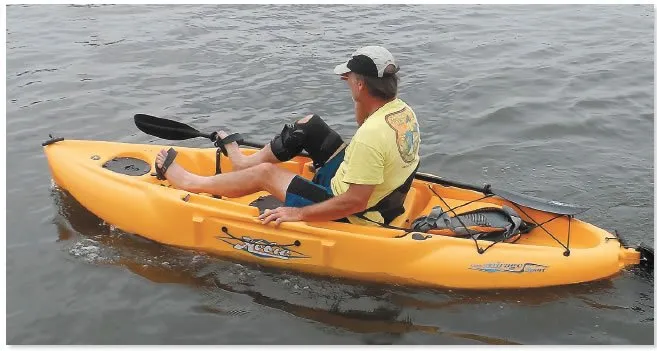
Observations
Durability is hard to judge, because it depends on the intended use. Most hard kayaks can bounce off river rocks and docks with only cosmetic damage. Inflatables and pedal-drive boats are generally more vulnerable to abuse, but they can put up with quite a bit of banging. We took smaller and inflatable kayaks aboard for testing, while the larger pedal boats were tested from shore. Some of the inflatables were clearly more ruggedly built than others. Here are some more specific details testers noted:
Thigh braces. Much of the stability of any kayak in waves comes from your ability to control the boat with your hips and feet. With a sit-in kayak, the feet are on sturdy foot braces and the thighs bear against padded thigh braces.
Better kayaks, such as the Aspire, include perfectly fitted thigh lifters under the seat to offer excellent control. Whitewater kayaks and slender sea kayaks are fitted with foam pads around the hips to further improve control. Recreational kayaks often lack these straps, but both inflatable and rigid kayaks can be fitted with thigh brace straps. None of the sit-on kayaks we tested were fitted with thigh braces, but in those cases, we often rigged a temporary set using rope. Thigh braces can be purchased as an accessory for $25-$45. Obviously, they can’t be used when pedaling a pedal kayak.
The Walker Bay Airis Sport became powerful and responsive when fitted with simple rope braces. You should be able to vigorously rock a kayak with your hips-this ensures effective power transfer and stability in waves. Walker Bay and Ocean Kayak offers thigh straps as accessories, and there are many aftermarket vendors.
All-day comfort. Hard kayaks generally have an edge over inflatables because they tend to feature better footrests and backrests. Sit-in or sit-on kayaks are about the same in terms of comfort, but getting the right fit is like picking a shoe. Our testers rated the Aspire and the Hobie Sport as the most comfortable overall.
Efficiency. Novice paddlers have an inefficient paddle stroke, using elbows, wrists, and arms to provide the power; for them, pedal power can be far better for covering long distances. Experienced paddlers have a more efficient stroke, using core muscles instead of arms, and can maintain a stead pace for long periods without fatigue. Pedal-powered boats must be wide and heavy for stability, and this offsets some of the efficiency of leg power. It also makes them much slower when paddled
Maneuverability. If you like nosing around the back corners of marinas and deep inside marshes, paddling is more efficient.
Inflatable Kayaks
Ranging from big-box store models that are little more than heavy-duty toys, to serious high-pressure inflatables, these may be the only practical option for smaller boats. Downsides include vulnerability to puncture and UV exposure, and the time to inflate-some of the models we tested required a daily top-off pump. Another downside is quality control.
There are countless inflatable boat factories around the world, and the quality of construction varies greatly. Our testers focused only on familiar brands with certification from the National Marine Manufacturers Association (there is an equivalent ISO standard), but we still we found a wide differences in durability and warranty coverage. A key detail that marks a better boat is the inflation PSI for the floors chambers. Higher PSI means a stiffer, and generally better-built boat.
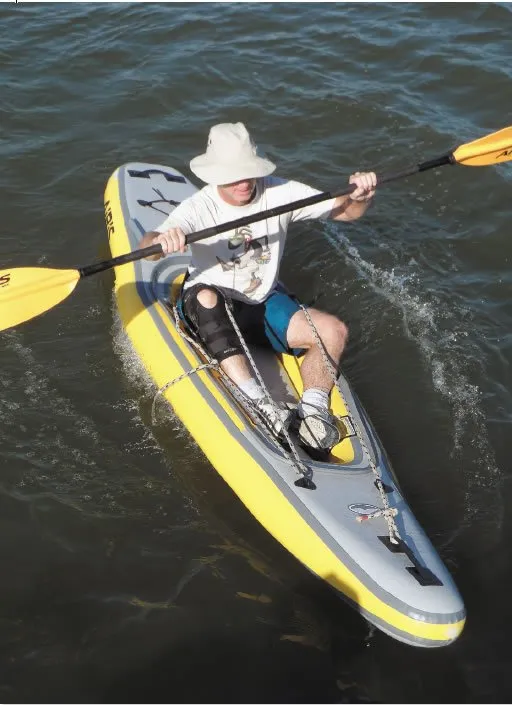
Walker Bay Airis Series
With a long history of building practical tenders, Walker Bay has used their air-web high pressure inflatable technology to create two extremely light and suitably stiff kayaks-the Sport, and the smaller Play-that are truly in a different category from lower pressure inflatables. Both models are sit-on kayaks.
The Sport is two pounds heavier and 26 inches longer than the Play. The Play is great for surf, but the Sport has more capacity, better tracking, and strikes us as the better choice for sailors. Equipped with optional (highly recommended) thigh braces, the sit-on Sport is powerful and responsive, a pleasure to paddle even in waves and chop. A deluxe backrest is available as an option.
During on-the-water testing, it felt a little unstable and tentative, but when we added thigh braces it came alive. Its lightness and rigidity allowing it to tackle rough conditions energetically. It takes only five-minutes to set up. If you do manage to capsize, reboarding from the water was easy.
Bottom line: We found the Walker Bay Sport to be fun and light. It is our Best Choice inflatable kayak.
Stearns Sea Eagle 330
The least expensive kayak in our test, the Sea Eagle is better than what you might expect for less than $250, but it lags far behind the high-pressure inflatables in our test. Our testers found the hull when inflated to the relatively low specified PSI of 1.1 pounds was too soft to paddle efficiently. Sea Eagle has two other lines of kayaks with higher-pressure hulls, the FastTrack (3.2 psi), and the RazorLite (10 psi) that look more promising, but we have not tested these yet.
The SE 330 is stable and cheap, and with a second seat installed, it is one of the least expensive ways to get two people to shore. None of the other makers had kayaks in this price range that can do this.
Bottom line: This is our cheapest option, but its one step above a beach toy compared to the others in this category. Its not much fun to paddle and construction is light, but we imagine it will sell like hotcakes after what happened in Houston.
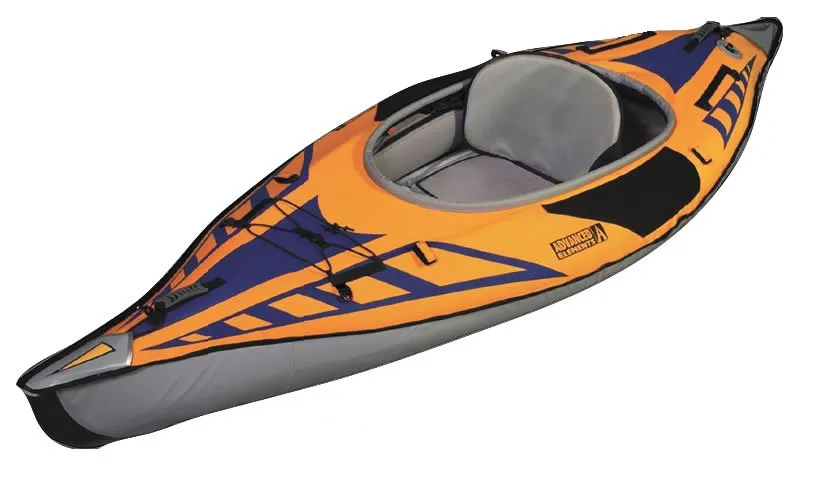
Advanced Elements Advanced Frame Sport Kayak
Advanced Elements has nearly a dozen models of inflatable boats to choose from, and several of them have low-pressure (2 psi) hulls stiffened with metal tubes to provide rigidity. The Sport model is one of the least expensive in its lineup.
The metal reinforcements suggested that this sit-in inflatable would be a stiff boat, but the high-density drop-stitched floor was soft, and the keel was ineffective, causing the boat to wander. (Advanced Elements has other inflatable models, like the 4.5-psi Airfusion Elite, which may perform better.)
On the plus side, it was quite stable, and the owners we interviewed were very fond of their boats. Because of the metal reinforcing elements, set-up takes longer than other inflatables (at least ten minutes) and requires a flat space.
Bottom Line: Modest performance coupled with an entry-level price makes this our Budget Buy in inflatable kayaks.
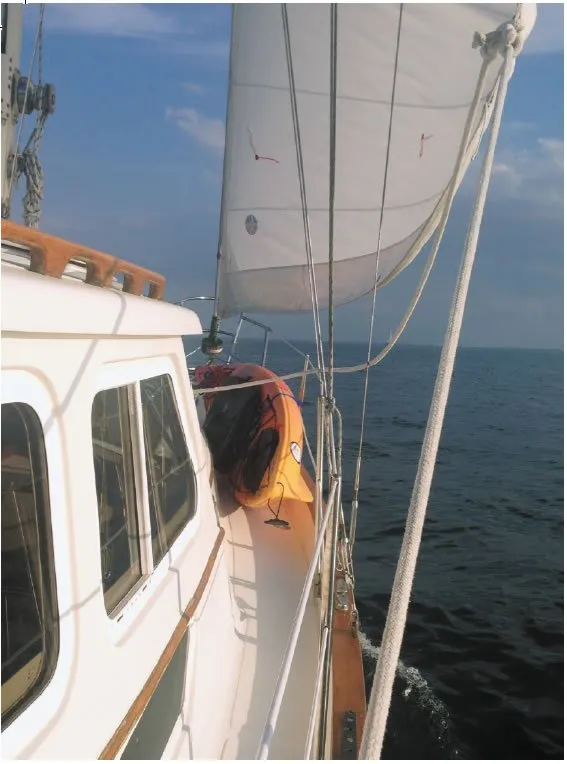
Traditional SIT-IN Kayaks
The preferred choice for serious paddlers, sit-in kayaks can cover a lot of water in the right hands. Getting the right fit is more important than it is for sit-on kayaks, so be sure to give your choice a good test run.
Perception Impulse
A longtime player in the kayak market and an innovator of the plastic kayak, Perception sells dozens of models, including tandems, stand up paddleboards, and a hybrid SUP/kayak it calls the Hi-Life. The simple, sit-in Impulse is a modestly priced recreational model. It features an impressive combination of lightness and good speed for such a short boat. It is much faster than most kayaks in its class. The seat is comfortable, and there are no extra compartments to keep clean. Perception made their name with white water kayaks, and weve bashed rocks with this one through many miles of easy rapids. Its tough. Weve also used it as tender for seven years on one of our test boats.
Bottom Line: This rugged no-nonsense kayak is our Budget Buy in the category of traditional kayaks.
Wilderness Systems Aspire 105
The retractable skeg technically places this kayak in the crossover category, bridging recreational and easy whitewater capabilities. Increased rocker and a flat bottom allow fast turning, and a full bow helps it ride over waves. When the skeg is lowered, it tracks straight.
The downsides to this model are its increased weight, and slightly slower paddling, although it is still faster than the inflatable or sit-on kayaks. The seat includes advanced adjustments not typically found in recreational kayaks (seatback height and angle, and angle/height of the seat bottom), making for true all-day comfort, and allowing positions that are comfortable for both laid-back cruising and vigorous paddling in waves.
The low seating position and flat bottom make for incredible stability, making it suitable for fishing and photography. Wilderness Systems is also known for its whitewater kayaks, which have survived countless collisions with rocks and boulders.
Bottom Line: Comfort and performance make this our Best Choice for sit-in kayaks.
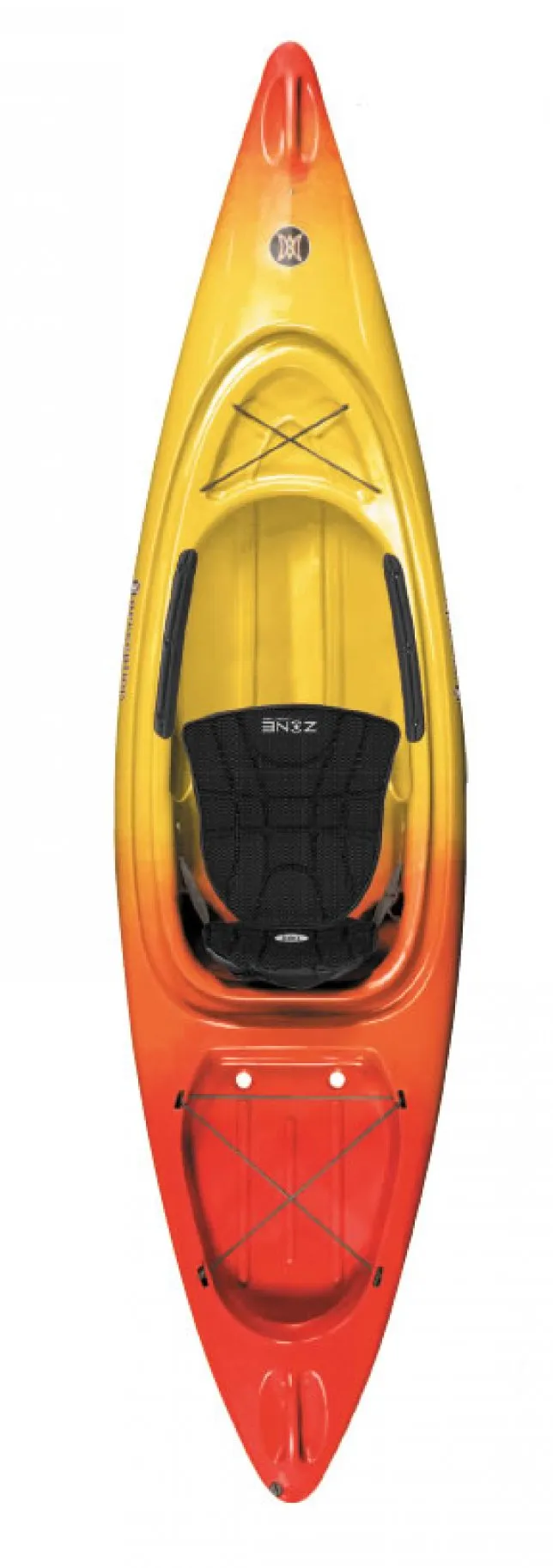
Sit-on
Sit-on kayaks are best suited for warmer waters where the paddler doesn’t mind being a little wet, or is in and out of the water a lot-sailboat to reef to beach.
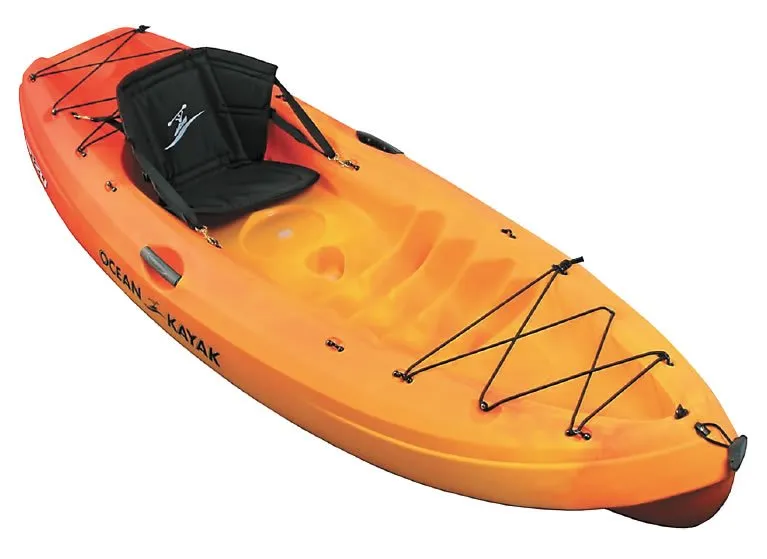
Although testers found the Frenzy from Ocean Kayaks to be too uncomfortable for long cruising and not particularly fast, it is compact and capable in rough water, particularly when fitted with thigh braces. Weve enjoyed this Frenzy playing in the surf and snorkeling reefs. Solid foot rests molded into the hull offer a firm bracing
Bottom line: Best Choice in the sit-on category.
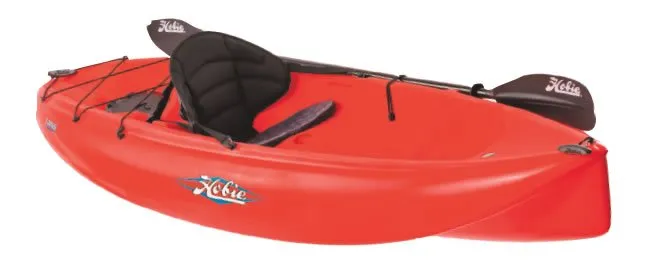
Hobie has a wide range of models, including some cool sailing models that weve reviewed in the past. Most of their models, however, are priced well above the $800 target we set for non-pedal kayaks. The Hobie Lanai is a compact entry-level boat that benefits from Hobies wide dealer support and variety of accessories.
The stackable design would be an advantage to a sailing club looking to add to their fleet, but it offers little else that sets it above the rest. It has a cargo area with a bungee tie-down and a padded seat. We liked the simple ruggedness of the boat, but its just a little heavy compared to others in the field.
Bottom line: Recommended.
Pedal drives
Kayaks are pretty simple boats, consisting of a hull, seat, and paddles. Pedal-drive kayaks have a drive mechanism that is well engineered but complex. The Perception Pilot system resembles a sail drive powered by bicycle pedals. Reverse is a matter of peddling backwards. The Hobie Mirage drive consists of two fins that flap like penguin flippers. Both systems need a rudder to steer, and the propulsion drive can be either folded up against the hull (in the Hobie) or retracted (in the Perception) for shallow-water paddling.
Because you are using your powerful leg muscles, the miles melt away. An experienced paddler can nearly keep up with a pedal boat, but it will take practice and stamina. Pedal kayaks are particularly handy for the fishermen, photographers, bird-watchers or anyone who wants their hands free underway.
Pedal kayaks are less maneuverable than conventional types. They are also less stable, but mainly because a paddle, when extended, helps with stability.
Although these are rugged drive systems, some of the small components are vulnerable, particularly in salt water. The Hobie system, for example, features a stainless drive chain that is susceptible to corrosion in saltwater. Youll want a spare for extended cruising. Several owners we interviewed described repairs to the drives. During one of our tests a small part broke off.
We tested three pedal boats, one from Perception and two from Hobie, but only the Hobie Sport was light enough to be easily hoisted aboard.
Hobie Mirage Outback
Designed for stability, this kayak is remarkably fast under pedal power-testimony to the efficiency of the Mirage drive system. The substantial beam, weight, and elevated seating position make this a comfortable boat for all-day fishing, but we had our doubts as how it would fare in waves because of the high seat. At 95 pounds, its a noticeably more bulky compared to the Sport.
Bottom line: The best of the bunch for flat-water fishing. Recommended for the serious angler.
Hobie Mirage Sport
At 70 pounds, the Mirage Sport is still heavy, but the mass is manageable under pedal power. Maneuvering is sluggish compared to a paddle kayak, and launching and retrieving requires a few extra steps. The rudder must be folded up, the drive removed, and youll still need a halyard to haul it over the side. Hobie has introduced an upgraded seat that lifts you about three inches above the floor, but the older-style seat offers more stability. This is the most paddle-friendly of the peddle-powered range, though it is maneuvers sluggishly.
Bottom line: Recommended. Light and compact, this is the most sensible pedal drive for sailors that we tested.

Perceptions Pilot drive is basically a foot-powered sail drive. Testers found the motion natural and the stability reasonable. Although the drive is more awkward to remove, testers liked that it could be easily tipped up in shallow water, and reversing by peddling backwards was easier than shifting into reverse with the Mirage drive.
Bottom Line: This is a nifty setup for the fisherman, but a little too much boat for most average sized cruisers.
Conclusions
Personal preferences play a big role in any dinghy decision, and kayaks are no exception. Each of the kayaks that our testers recommended excel at one or more basic needs of the cruising sailor: transportation, exercise, fishing, or exploring. Some of the decisions will depend on the climate you sail in. We welcome any comments from owners on their experience with specific kayaks.
The higher-grade inflatables, especially the Airis, are delightfully light, easy to store, and paddle well in all conditions-perfect for exercise, exploring, even a bit of wave riding in warm waters. The well-designed hard kayaks, however, are more responsive and offer better durability over the long haul.
Sit-in kayaks deliver superior seaworthiness and protection for the four-season paddler who wants to keep his seat dry. Sit-on kayaks offer fun in the sun and easier reboarding from the water, should you decide to take a swim or snorkel break.
Pedal drive is great for fishing and sailors with shoulder problems, as long as you can accept the added weight, maintenance, and assembly time. In the interest of compactness and simplicity, our testers generally preferred paddle kayaks over pedal for long term cruising. A paddled kayak is also more stable in rough water.
Our testers were unanimously in favor of the sit-in style of kayak. Although you may have different preferences than they do, we recommend at least trying a conventional sit-in style paddle kayak before making buying. Certainly, other kayak designs can better meet specific needs, but its hard to argue against the overall utility of a design thats been around for more than 5,000 years.
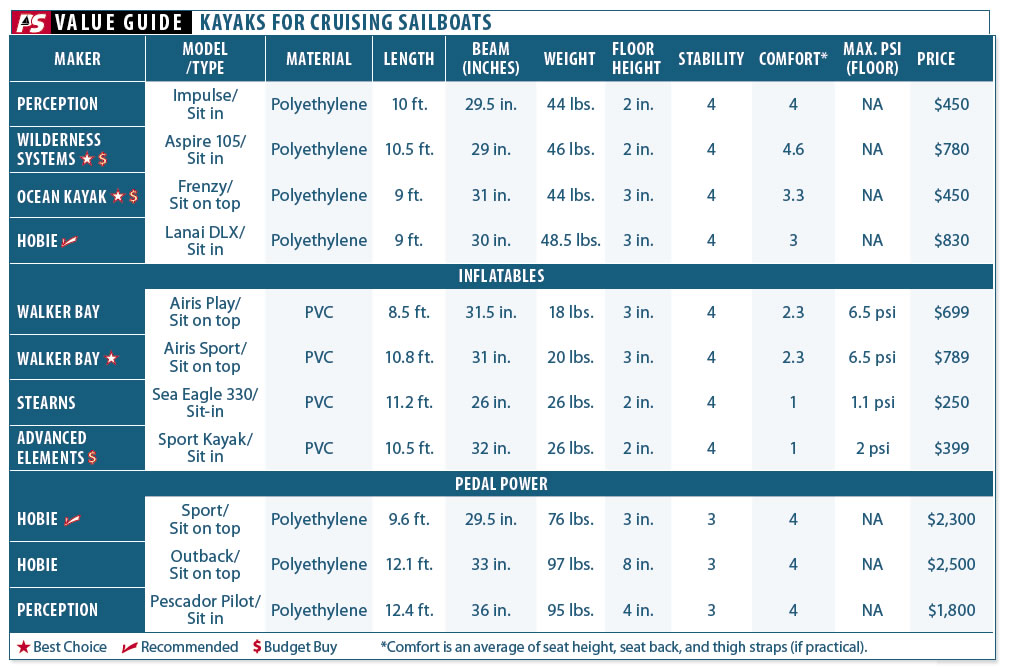

































Another consideration: Safety. Sit-in kayaks are easy to climb back on if you roll over and find yourself in the water. Unless you are very athletic and have specific training, righting a swamped a sit-in kayak, bailing and climbing back in to it is nearly impossible.
Oops, I meant sit-on kayaks are easier to climb back on than sit-ins after a rollover. Sorry
Interesting article as I was looking for an inflatable kayak. Unfortunately, the recommended Walker Bay kayak seems to no longer be available. It wasn’t until I tried to find the kayak that I realized the article was from 2017 and not updated. Why are you sending out the article as if it is current information when it is 4 years old?
Yes, I agree. I’ve spent the last two hours looking for the deluxe seatback for my Airis Sport – not realizing this article was 4 years old. It’s very disappointing to find that Airis is no longer made but it explains why I was having so much trouble.
We have been cruising Mexico for 5 years with the Hobie I-11s peddle kayak/SUP, Did 10 miles today,5 back into 15kts and 1-2 foot slop. In and out of caves with the reverse drive,over submerged rocks 4” deep.
Yes priced up there but also a good work platform, if you would like more info and pictures just email me.
John
Monique@bajafogcat.com
We use a 14′ inflatable from AIRE as our tender. Great company and product. Terrific support also. Almost impossible to roll over, self bailing and good for 2 people with gear. Stores easily aboard our Jeaneau 42DS. Anyone looking for a kayak will do well checking with AIRE. Should have been considered for the article.
Robert Fegan
For “foldable” kayaks be sure to check out Pakayak (https://pakayak.com). 14’2” sea kayak that breaks down into 6 pieces that nest like Russian dolls into a bag about 3.5’ x 2’ x 1.5’ They’ve had Covid related production issues are are behind on shipping, but they’re getting rave reviews. They are on the expensive side but not too far off comparable single piece sea kayaks of similar size. I ordered mine last April… it was supposed to be delivered yesterday but the snow has delayed FedEx. I plan to carrying mine aboard my Tartan 37.
One of the functions of a cruising tender is to haul people, gear, and supplies to and from the boat. Most of the kayaks in this review seem woefully inadequate for that task. I have an inflatable Sea Eagle 380 that has a reported load capacity of 750 pounds. It is very stable and its drop stitched high pressure floor is ridged enough to stand up in. With its removable hard skeg it tracks reasonably well. At about $1000 it’s not cheap, but it is well made and very versatile.
I suggest you do a separate review of inflatable kayaks. In my experience they are superior in almost every respect to rigid hull kayaks as tenders. More stable, easier to re-board if one should ever capsize, greater capacity, less potential for causing injury and damage when launching and retrieving, easier to repair if they are ever damaged, light weight, flexible enough to be stowed on deck in narrow or irregular spaces, can be deflated for compact stowing, and most are self bailing, which is an advantage if you decide to tow part of the time. I have a couple, including an Airis, which is no longer sold. Aire, Sea Eagle, Aquaglide, Advanced Elements, Innova/Gumotex are among many reputable, high quality brands.
I was planning to get a kayak – but first I got a set of inflatable SUPs – one for the captain and two (small and light kid models) for the crew. Haven’t looked back – really wonderful for fun and exploration and so, so portable. Only drawback: in a breeze you might have to kneel or sit to reduce windage (yes, like a kayak
I recently shopped for an inflatable kayak to serve as an easily deployed tender. The Aire double is perhaps the best designed for this use, but in the end I bought a Maverick II from NRS (Northwest River Supply) for its quality construction and Hypalon material (now called Pennel Orca). In the sun and heat of the Sea of Cortez PVC boats are essentially disposable after two or three years. The Maverick works well and can carry a lot of supplies. I fitted a bow D ring for towing/tying up and added rope thigh braces. It is a whitewater boat and requires relatively skilled paddling and an efficient forward stroke, but a good choice for the right paddler. It is expensive but should last–I am still using a Hypalon Avon dinghy I purchased in 1987–hard to assemble and needs attention but the material is still good after all those years in Baja.